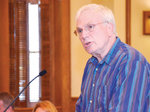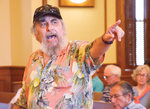


PITTSBORO — The dispute over the confederate monument at the historic Chatham County Courthouse in Pittsboro seems to have struck a more conciliatory tone as evidenced by the Chatham County Board of Commissioners’ regular meeting on Monday.
Before and during the meeting in the courthouse, the statue outside, which was surrounded by barricades, stood alone — there were no protesters around it from either side of the debate. And the tone of the speakers addressing commissioners on the topic, of which there only a handful, was more friendly than combative.
Howard Fifer, one of the spokespersons for the group “Chatham for All” — which originally presented the request to remove the statue from its current location in front of the courthouse — believes that was because of the leadership of the county board and its chairman, Mike Dasher, in trying to bring people together despite the divisive topic.
It was evident in the board’s action, too. The board voted unanimously to enter into a “memo of understanding” with the Winnie Davis Chapter of the United Daughters of the Confederacy, which owns the statue though it sits on county property, to “meet, cooperate, and work together in good faith” to develop a framework for the future of the monument. Such types of discussions and agreements regarding the placement of confederate statues in the modern era is novel, at least in North Carolina.
Fifer believes that conversations with those on opposite sides of the issue are invaluable and has, for every board meeting where the subject has been discussed, reached out to those who support keeping the statue as it is to open lines of communication.
“It doesn’t mean they are going to change my mind or that I’m going to change their mind,” he said. “Hopefully there’s more of an understanding. I do respect other people’s point of view even when I don’t agree with them. To me, it’s heartening that people can communicate, can talk, can compromise to reach a point where everybody gets a little less than they want.”
In introducing the memo, Dasher recapped “for the record” the issue. In April, the board received a presentation from citizens regarding the monument outside the courthouse. Those who participated in the presentation noted that while state law prohibits the removal of publicly owned statues, this one was “unique” as it was owned by the United Daughters of the Confederacy and located on county property “pursuant to a license agreement.”
“It is my understanding that a majority of the commissioners find that argument persuasive and are of the opinion that the county is within its rights to return the monument to the UDC,” Dasher said.
“However, this board, as constituted, first and always will seek those resolutions that people of good will on both side can find acceptable,” he continued.
Dasher met with UDC Chapter President Barbara Pugh and the two agreed that together they could work together to decide the future of the monument. The memo of understanding is the result of those conversations. The memo explicitly states that it “does not commit either party to any particular course of action, but does commit both parties to discussions and negotiations in good faith concerning the monument.”
Chatham resident Larry Ballas, a supporter of the confederate monument staying place, noted in his public comments Monday that while he thinks the monument celebrates “a history of people who defended the state” and preferred it not be moved, he stated that if the end result was to move the statue, he requested that it would be moved “someplace public.”
County resident Woody Weaver, who spoke passionately about the statue, noted that if the statue were to be changed, he would not want the words “white” or “black” nor would he want the word “slavery” on the monument, but “Chatham citizen.” He also noted that he agreed with the path the board is taking toward a resolution with the UDC, but asked that others in the community be involved in the discussion.
Fifer, who spoke on behalf of Chatham for All, whose supporters filled more than half the courthouse pews, expressed gratitude to the board for the “leadership you continue to demonstrate.” He also noted that the group does not “necessarily agree” with the board’s invitation to the UDC to be a participant in the process of determining the statue’s future.
“We do, however, understand that they are the owners of the monument, and as such we accept your non-judgmental stance in attempting to work together with them — but remind you that you and you alone have the legal authority to act,” Fifer said.
“Our public spaces speak for all of us — and we have a responsibility to ensure our civic spaces promote sound American values,” he said.
During the board’s discussion of the memo of understanding, several commissioners voiced support for the memo.
What’s important to note is that this is a framework for opening up a conversation,” Commissioner Karen Howard said. “It doesn’t mean we will compromise the integrity or the views of this board.
“I also think it places us in a conciliatory and forward-thinking position to work with the Daughters of the Confederacy and move forward,” she said.
“I think this is an appropriate step,” Commissioner Diana Hales said. “There may be certain things that may not be on the table, but let’s start with what can be on the table. I think that’s an adequate place to begin.”
“I think we can reach some endpoint, but let’s figure out how we move to that endpoint,” she said.
Commissioner Jim Crawford said he would not care about the monument “if it were in a public cemetery or certainly on private property, but it sits at the seat of government where we make rules.”
“I can support this [memo of understanding], but personally, I believe it should be moved to a place where it can be viewed, but where it is not at the seat of government,” he said.
Howard also noted that during these discussions, there has been “misinformation” and she has often heard an “unwillingness to learn new things, to hear new information,” but believes that “at the very least, this board has demonstrated a willingness to hear, to listen.”
Crawford, who earned a PhD in U.S. History from UNC-Chapel Hill, also noted concerns over a lack of clarity and understanding of history as well. Crawford noted that throughout the discussions, some have noted that slaves fought side-by-side with the Confederacy.
“At most there were 6,000 people of color dragooned into fighting for the Confederacy, half of whom switched sides,” he said. “And that in no way compares to the 180,000 African-American soldiers that fought for the Union.”